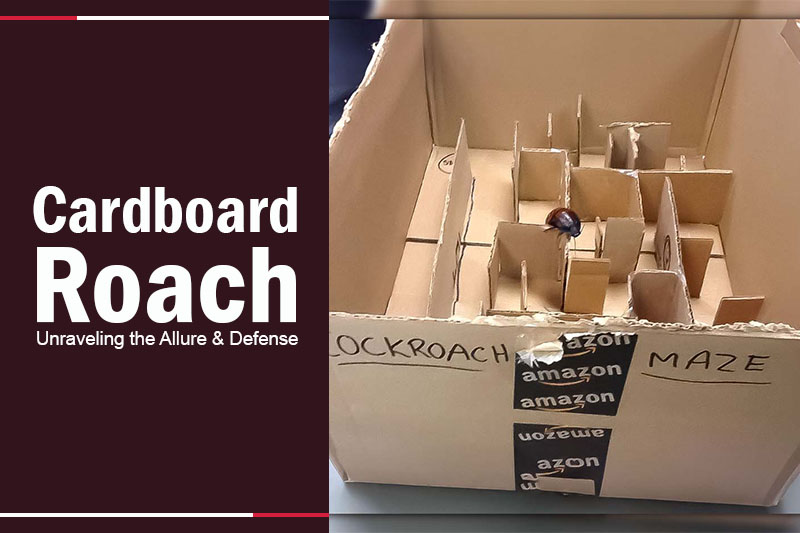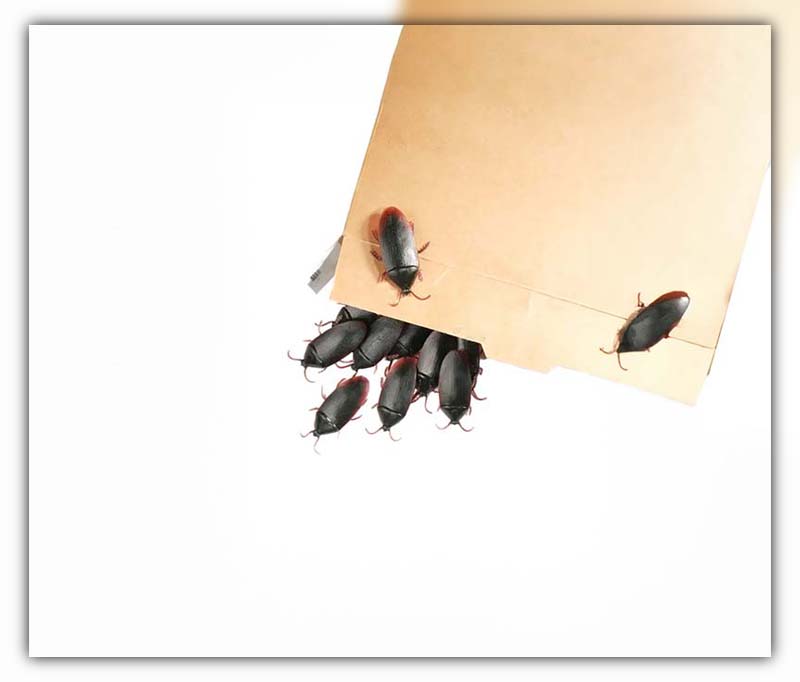Cardboard boxes: essential for storage, yet a hotspot for roaches.
Discover the reasons behind the “cardboard roach” attraction and arm yourself with knowledge to deter these pests.
Explore this comprehensive guide to understand why these critters are drawn to cardboard and how you can safeguard your home from an unwelcome infestation.

Do Roaches Like Cardboard?
Yes, roaches are drawn to cardboard due to various factors. Cardboard is composed of organic materials like tree fibers and glue that roaches find edible.
Moreover, cardboard offers roaches protection, moisture, and darkness – perfect conditions for their survival and reproduction.
Also, cardboard boxes are typically kept in areas with minimal human activity like garages, attics, or basements, making them even more appealing to these pests.
Read more Can a cockroach live in your Penis? Truth and Myths!
Why Do Cockroaches Like Cardboard?
It offers food sources
Cardboards are composed of organic materials, including tree fibers, and the glue used in its production emits a sweet aroma that further attracts them.
It provides shelter
When cockroaches search for food and shelter in a home, their flexible bodies enable them to squeeze into even the smallest gaps.
Unsealed boxes become an inviting space for them to settle.
It offers moisture and darkness
Cardboard can retain significant amounts of moisture and is often kept in dark, secluded areas.
These conditions make it a prime habitat for roaches.
Can Cockroaches Inhabit Cardboard Boxes?
Cardboard boxes are often stored in areas of the home that are dark and isolated, providing easy routes to different sections of the dwelling. These locations offer various advantages for roaches:
- Attics offer warmth, darkness, and privacy.
- Basements can be prone to leaks or flooding, leading to dampness and mold.
- Closets may contain paper or cloth items that serve as food sources for roaches.
- Laundry rooms provide both moisture and fabric materials.
- Crawl spaces grant access to various parts of the house.
Even the smaller boxes that store packaged foods in the pantry can attract roaches. Given the shelter that cardboard offers, roaches can thrive without much disturbance.
Can Cockroaches Gnaw Through Cardboard?
Cardboard is created by compressing several layers of paper pulp using industrial machines, resulting in a sturdy and dense structure that can support weight and resist harm.
Roaches, with their mandibles, can’t chew through undamaged cardboard. If you observe bite marks on it, they’re likely caused by other pests like mice. But if the cardboard is weakened by time or moisture, it becomes easier for roaches to bite through.
Aged cardboard
Over time and with repeated use, a cardboard box can degrade and exhibit signs of wear, such as:
- Becoming ripped or torn.
- Turning brittle or soft.
- Thinning.
- Separating at the seams.
In these compromised states, it’s easier for roaches to chew through the cardboard. Typically, cardboard has a robust exterior with inner pockets or ribbing, making it durable yet lightweight. If the outer layer is damaged, roaches can easily access the more vulnerable inner layers.
Damp cardboard
Storing cardboard in places like sheds, basements, or garages can expose it to moisture, leading to water damage. This causes the cardboard fibers to lose their strength and detach from one another.
The resulting weakened exterior and thinned inner ribbing make it simpler for roaches to chew through. Additionally, the damp cardboard can provide roaches with a source of water.
Cardboard adhesive
Roaches, if unable to feed on cardboard, will target the glue instead.
This adhesive supplies roaches with essential nutrients like fats, proteins, and carbohydrates. Boxes that are damaged or showing signs of wear tend to have more exposed glue, making it accessible for roaches.
As noted in the Journal of Economic Entomology, roaches have the remarkable ability to live for over 50 days without food or water. Even a minor intake of cardboard adhesive can provide nourishment for them for an extended period.
Preventing Cockroaches in Cardboard
Cockroaches have a particular affinity for cardboard, and since many households frequently have cardboard items, it’s vital to recognize this and take precautionary measures.
Cardboard boxes offer an ideal environment for roaches to reside, establish nests, and reproduce, particularly when they’re situated in humid, warm places like garages. Beyond just providing shelter, these boxes also serve as a source of nutrition for these pests due to their organic fiber composition.
To deter roaches from setting up shop in your cardboard, consider the following preventative actions:
- Maintain Dryness: Ensure that boxes are stored in dry locations, as roaches are drawn to moisture.
- Reduce Available Food: Avoid leaving food remnants in or around the boxes, which can be enticing for these insects.
- Properly Seal Boxes: Use robust boxes without any damage and secure them with tape to minimize entry points for roaches.
- Regular Inspections: Periodically review your stored boxes for any signs of wear or roach activity. Addressing any potential issue early can prevent a full-blown infestation.
Where Cockroaches Often Hide?
Storing in Cardboard Boxes
Cardboard is highly enticing for roaches, so places with a significant number of cardboard boxes are more likely to attract these pests.
Storing them in moisture-prone, dimly lit spaces such as garages, attics, or basements enhances their appeal to roaches.
Furthermore, the contents within the boxes matter. Boxes housing organic materials, whether it’s food or paper items like books, amplify the attraction factor for roaches.
Hidden Areas
Beyond the typical storage spots, roaches can also take refuge in the quieter corners of your home, such as places where boxes are tucked away. Closets are a prime example of this.
Since roaches prefer to stay away from human activity, they naturally seek out these less-frequented spaces.
The presence of materials like cardboard in these areas, offering both shelter and nourishment, only makes them more appealing to these pests.
Read more How to get rid of cockroaches behind Fridge
Preventing Infestations
Tips for Cleaning
Roaches gravitate towards food sources, so it’s essential to ensure no food remnants or crumbs are left in the boxes in your home.
For boxes containing nonperishable foods, regular checks are crucial to ensure they remain tightly sealed.
Maintaining cleanliness throughout your home is equally important.
To reduce the risk of a roach infestation, keep your floors clean by sweeping and mopping frequently and promptly discard any expired or spoiled food.
Effective Storage Tips
Opt for plastic bins with secure-fitting lids rather than cardboard when possible. Maintain a tidy and organized storage space, particularly if it contains food items.
If cardboard is necessary, store it in dry, clean areas and make sure to seal any openings securely with tape.
Ways to Control Pests
Natural remedies like essential oils, including lavender, peppermint, and eucalyptus, can help deter cockroaches and other pests. To use them, apply a few drops onto cotton balls and position them in potential risk areas.
Boric acid is another effective method. Combine it with sugar or flour as bait for roaches. While the sugar or flour draws them in, the boric acid will exterminate them. However, ensure that boric acid is placed away from children and pets, as it can be harmful if ingested.
Read more Cockroach boric acid: Quick Guide to a Roach-Free Home.
Conclusion
In sum, the allure of cardboard to roaches is a multifaceted issue, rooted in the cardboard’s inherent properties and the environments we often store it in. The “cardboard roach” relationship is one that many homeowners encounter, with cardboard providing both sustenance and shelter for these persistent pests.
As you navigate the challenges of keeping roaches at bay, we’d love to hear your personal experiences and insights. Feel free to share your stories, and for more insights into pest control, don’t forget to explore more informative blogs from Pestweek.

Calina Mabel has over 15 years of experience in the field of journalism and communications. Currently, Calina Mabel is the Content Writer for categories such as Cockroach, Ants, Bed Bugs, Mosquito, Rodent, Termite, and Flies on Pestweek.com. She aims to build content for these categories with a focus on providing valuable and accessible information to readers, in order to create the world’s largest knowledge community about Pests.
All content written by Calina Mabel has been reviewed by Emily Carter.





